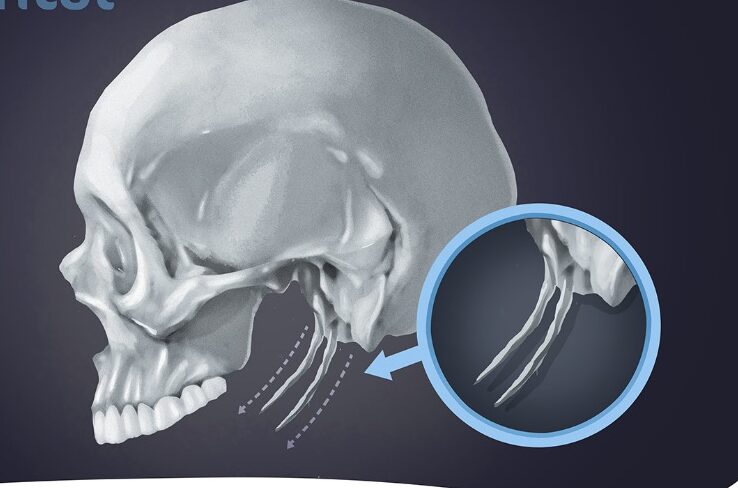Eagle’s syndrome is a rare and often underdiagnosed condition that can cause significant discomfort in affected patients. However, it is a complex disease that is often difficult to diagnose.
This syndrome is associated with anatomical abnormalities in the region of the styloid bone and the stylohyoid ligament, which manifest in a series of symptoms, from orofacial pain to swallowing difficulties and neurological problems.
Because it is a condition that is difficult for dentists to manage, in this article, we will explore in depth the characteristics, causes, symptoms, diagnosis and treatment options for this condition, as well as provide an overview of its importance. Check it out!
What is Eagle’s syndrome?
Eagle syndrome is characterized by abnormal elongation of the styloid process of the temporal bone or excessive calcification of the stylohyoid ligament.
The styloid process is a small bony projection located below the ear at the base of the skull. Normally, this process measures between 2.5 cm and 3 cm, but in patients with Eagle syndrome, it can elongate to more than 4 cm, causing compression or irritation of adjacent structures, including nerves and blood vessels.
The condition was first described in 1937 by American physician Dr. Watt Weems Eagle, hence the syndrome’s name. Eagle noticed that patients’ symptoms were often attributed to elongation of the styloid process or calcification of the stylohyoid ligament.
Causes of Eagle’s syndrome
The exact causes of Eagle Syndrome are not yet fully understood. However, there is evidence linking the condition to trauma or surgery to the neck and throat area.
Genetic factors may also play a role, as elongation of the styloid process has been observed to run in some families. Additionally, some studies indicate that the condition may arise as a result of degenerative or inflammatory processes affecting the ligaments and soft tissues of the cervical region.
Two main forms of the syndrome have been identified:
1. Classic Eagle Syndrome
Classic syndrome is often associated with previous trauma or surgery to the tonsils. Therefore, after removal of the tonsils, scar tissue may form around the elongated styloid process, which can result in nerve compression and pain. Symptoms include sore throat, foreign body sensation, difficulty swallowing, and pain radiating to the ear.
Therefore, patients who have had their tonsils removed and complain of these symptoms should be investigated.
2. Stylocarotid syndrome
The second form of the syndrome occurs when the elongated or calcified styloid process compresses the internal or external carotid arteries, causing neurological symptoms.
This can include headaches, dizziness, blurred vision, syncope, and even ischemic symptoms such as transient ischemic attack (TIA) or stroke.
Symptoms of Eagle Syndrome
Symptoms of Eagle Syndrome can vary considerably from person to person, depending on the severity of the condition and which structures are being compressed or irritated.
Therefore, symptoms are often intermittent and can worsen due to neck movements, chewing or yawning.
Main symptoms of Classic Syndrome:
- Pain in the throat and neck : often described as a sharp pain or burning sensation, located in the jaw area or under the jawbone.
- Sensation of a foreign body in the throat : Some patients report feeling as if something is stuck in their throat.
- Difficulty swallowing (dysphagia) : Pain when swallowing can be severe, and patients often avoid eating solid foods.
- Pain radiating to the ear (otalgia) : Ear pain, although common, is often not related to hearing problems.
- Facial pain : This can radiate to the jaw, tongue, or even the back of the head.
- Voice changes : In some cases, there are mild vocal changes, such as hoarseness or difficulty speaking.
Symptoms of Stylocarotid Syndrome:
- Headaches : Headaches can occur mainly in the temporomandibular or cervical region.
- Dizziness and vertigo : The styloid process can press on the carotid artery, leading to symptoms of decreased blood flow to the brain.
- Visual problems : Blurred or blurred vision is common, and there may be an increased risk of ocular ischemia.
- Syncope or fainting : In severe cases, arterial compression can lead to syncope.
- Transient neurological symptoms : including weakness, numbness, or even temporary partial paralysis, which can mimic a TIA or stroke.
Diagnosis of Eagle Syndrome
Diagnosing Eagle Syndrome can be challenging due to the nature of the symptoms, which often overlap with other more common medical conditions such as temporomandibular disorders, neuralgias or cervical problems.
Therefore, an accurate diagnosis usually involves a combination of physical examination, detailed medical history, and imaging tests.
Physical examination
During the physical examination, the styloid process in the tonsil region can be palpated and the patient asked to move the head and neck to determine whether the pain or symptoms are being provoked or worsened.
Imaging Exams
Definitive diagnosis is usually made by imaging tests. X-rays, computed tomography (CT) scans, and occasionally magnetic resonance imaging (MRI) are used to measure the length of the styloid process and identify any abnormal calcification of the stylohyoid ligament. However, CT scans are most commonly used because they provide detailed three-dimensional images of the bony structure.
In some cases, injections of local anesthetics into the area of the styloid process may help confirm the diagnosis. If the patient’s symptoms temporarily disappear after the injection, this indicates that the styloid process or calcified ligament is indeed causing the symptoms.
Treatment of Eagle Syndrome
Treatment for Eagle Syndrome varies depending on the severity of symptoms and the degree of involvement of anatomical structures. In mild cases, conservative treatment may be effective, while more severe cases may require surgical intervention.
Conservative treatment
Conservative treatment is the first step for patients with mild to moderate symptoms. It may include:
- Pain medications : Nonsteroidal anti-inflammatory drugs (NSAIDs) such as ibuprofen can help relieve pain and inflammation.
- Physical therapy : Cervical mobilization techniques and exercises to strengthen the neck muscles can help reduce discomfort.
It is very important to carry out multidisciplinary work with these patients to ensure a good prognosis for the condition.
Surgical treatment
In severe cases, especially when conservative treatment fails, surgery may be needed to shorten or remove the elongated styloid process. The procedure is called a styloidectomy .
There are two main surgical approaches:
- Intraoral styloidectomy : The styloid process is removed through an incision inside the mouth, in the area of the tonsil. This approach avoids visible scarring, but may increase the risk of infection.
- Extraporal Styloidectomy : In this method, the styloid process is accessed through an incision in the neck, which provides a better direct view for the surgeon but leaves a small scar on the skin.
Both techniques are effective, and the choice of approach depends on the surgeon’s preference and the patient’s anatomy. Recovery time varies, but most patients experience significant relief of symptoms within a few weeks after surgery.
Prognosis and quality of life
The prognosis for patients with Eagle syndrome is generally good, especially in cases where surgery is successful. Many patients report complete or significant relief of symptoms after removal of the styloid process. However, as with any surgical procedure, there are risks, including infection, nerve injury, and inadequate healing.
It is important to remember that Eagle Syndrome is a chronic condition, and in some cases, symptoms may return even after treatment. Regular follow-up with an ear, nose, and throat (ENT) or maxillofacial surgeon is essential to ensure that any recurrences are managed appropriately.
Therefore, Eagle Syndrome is a debilitating condition that has a major impact on patients’ lives, and dentists play a major role in managing the disease. Dentists should therefore always seek to stay up to date on rare conditions, as they play an important role in both detecting the condition and in monitoring and collaborating with other specialists.
Conclusion
Eagle’s syndrome is a condition characterized by elongated styloid processes or calcified stylohyoid ligaments, which can lead to pain and discomfort in the throat, jaw, and neck. While often misdiagnosed, understanding its symptoms and treatment options is vital for effective management. Early intervention and a tailored approach can significantly improve the quality of life for those affected by this syndrome.
FOR FERDUR INFORMATION:https://techlicss.com/

